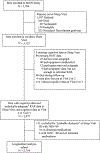Rest-Activity Rhythms and Cognitive Decline in Older Men: The Osteoporotic Fractures in Men Sleep Study
- PMID: 30136716
- PMCID: PMC6235690
- DOI: 10.1111/jgs.15555
Rest-Activity Rhythms and Cognitive Decline in Older Men: The Osteoporotic Fractures in Men Sleep Study
Abstract
Objective: To examine rest-activity circadian rhythm (RAR) and cognitive decline in older men.
Design: Longitudinal.
Setting: Osteoporotic Fractures in Men (MrOS) and ancillary Outcomes of Sleep Disorders in Men (MrOS Sleep) studies.
Participants: MrOS and MrOS Sleep participants (N=2,754; mean age 76.0 ± 5.3).
Measurements: The Modified Mini-Mental State examination (3MS) was used to assess cognition at baseline (2003-05) and follow-up examinations (2005-06 and 2007-09). Wrist actigraphy was used to measure 24-hour activity counts at baseline. RAR variables included amplitude (strength of activity rhythm), mesor (mean activity level), pseudo F-statistic (overall circadian rhythm robustness), and acrophase (time of daily peak activity).
Results: After an average of 3.4 ± 0.5 years, men with lower amplitudes, mesors, and pseudo F-statistics had greater decline in 3MS performance (amplitude: -0.7 points Q1 vs -0.5 points Q4, p<.001; mesor: -0.5 points Q1 vs -0.2 points Q4, p=.01; pseudo F-statistic: -0.5 points Q1 vs -0.3 points Q4, p<.001). Lower amplitudes and pseudo-F statistics were associated with greater odds of clinically significant cognitive decline (≥5-point decrease) (amplitude Q1 vs. Q4: odds ratio (OR)=1.4, 95% confidence interval (CI)=1.0-1.9; pseudo-F statistic Q1 vs Q4: OR=1.4, 95% CI=1.0-1.9). Men with phase-advanced acrophase had greater odds of clinically significant cognitive decline (OR=1.8, 95% CI=1.2-2.8). Results were adjusted for multiple confounders.
Conclusion: Several parameters of disrupted RAR (lower amplitude, pseudo F-statistic, mesor, phase-advanced acrophase) were associated with greater cognitive decline in older community-dwelling men. These findings contribute to a growing body of evidence suggesting that altered RARs are associated with cognitive decline in older adults. J Am Geriatr Soc 66:2136-2143, 2018.
Keywords: cognitive decline; men; rest-activity rhythm.
© 2018, Copyright the Authors Journal compilation © 2018, The American Geriatrics Society.
Conflict of interest statement
Conflicts of Interest: The authors report no conflicts of interest.
Figures


Similar articles
-
Rest-activity circadian rhythms and bone mineral density in elderly men.Bone Rep. 2017 Nov 10;7:156-163. doi: 10.1016/j.bonr.2017.11.001. eCollection 2017 Dec. Bone Rep. 2017. PMID: 29181439 Free PMC article.
-
Association of Circadian Abnormalities in Older Adults With an Increased Risk of Developing Parkinson Disease.JAMA Neurol. 2020 Oct 1;77(10):1270-1278. doi: 10.1001/jamaneurol.2020.1623. JAMA Neurol. 2020. PMID: 32539075 Free PMC article.
-
Rest-activity patterns and falls and fractures in older men.Osteoporos Int. 2017 Apr;28(4):1313-1322. doi: 10.1007/s00198-016-3874-2. Epub 2016 Dec 24. Osteoporos Int. 2017. PMID: 28013364 Free PMC article.
-
Disrupted daytime activity and altered sleep-wake patterns may predict transition to mild cognitive impairment or dementia: a critically appraised topic.Neurologist. 2012 Nov;18(6):426-9. doi: 10.1097/NRL.0b013e318272f7ef. Neurologist. 2012. PMID: 23114683 Review.
-
Actigraphic monitoring of sleep and circadian rest-activity rhythm in individuals with major depressive disorder or depressive symptoms: A meta-analysis.J Affect Disord. 2024 Sep 15;361:224-244. doi: 10.1016/j.jad.2024.05.155. Epub 2024 Jun 6. J Affect Disord. 2024. PMID: 38851435 Review.
Cited by
-
The Interactive Role of Sleep and Circadian Rhythms in Episodic Memory in Older Adults.J Gerontol A Biol Sci Med Sci. 2023 Oct 9;78(10):1844-1852. doi: 10.1093/gerona/glad112. J Gerontol A Biol Sci Med Sci. 2023. PMID: 37167439 Free PMC article. Review.
-
Light in the Senior Home: Effects of Dynamic and Individual Light Exposure on Sleep, Cognition, and Well-Being.Clocks Sleep. 2020 Dec 14;2(4):557-576. doi: 10.3390/clockssleep2040040. Clocks Sleep. 2020. PMID: 33327499 Free PMC article.
-
Beyond sleep: Rest and activity rhythm as a marker of preclinical and mild dementia in older adults with less education.Neurobiol Sleep Circadian Rhythms. 2024 Dec 25;18:100110. doi: 10.1016/j.nbscr.2024.100110. eCollection 2025 May. Neurobiol Sleep Circadian Rhythms. 2024. PMID: 39834590 Free PMC article.
-
Multidimensional sleep health domains in older men and women: an actigraphy factor analysis.Sleep. 2021 Feb 12;44(2):zsaa181. doi: 10.1093/sleep/zsaa181. Sleep. 2021. PMID: 32918075 Free PMC article.
-
Predicting cognitive scores from wearable-based digital physiological features using machine learning: data from a clinical trial in mild cognitive impairment.BMC Med. 2024 Jan 25;22(1):36. doi: 10.1186/s12916-024-03252-y. BMC Med. 2024. PMID: 38273340 Free PMC article.
References
-
- Chaudhury D, Colwell CS. Circadian modulation of learning and memory in fear-conditioned mice. Behav Brain Res 2002;133(1):95–108. - PubMed
-
- Kripke DF, Youngstedt SD, Elliott JA et al. Circadian phase in adults of contrasting ages. Chronobiol Int 2005;22(4):695–709. - PubMed
-
- Buysse DJ, Monk TH, Carrier J et al. Circadian patterns of sleep, sleepiness, and performance in older and younger adults. Sleep 2005;28(11):1365–1376. - PubMed
-
- Czeisler CA, Dumont M, Duffy JF et al. Association of sleep-wake habits in older people with changes in output of circadian pacemaker. Lancet 1992;340(8825):933–936. - PubMed
-
- Duffy JF, Zeitzer JM, Rimmer DW et al. Peak of circadian melatonin rhythm occurs later within the sleep of older subjects. Am J Physiol Endocrinol Metab 2002;282(2):E297–303. - PubMed
Publication types
MeSH terms
Grants and funding
- R01 HL070848/HL/NHLBI NIH HHS/United States
- R01 HL071194/HL/NHLBI NIH HHS/United States
- R01 HL070847/HL/NHLBI NIH HHS/United States
- UL1 TR000128/TR/NCATS NIH HHS/United States
- U01 AG042145/AG/NIA NIH HHS/United States
- U01 AG042168/AG/NIA NIH HHS/United States
- R01 HL070841/HL/NHLBI NIH HHS/United States
- R01 HL070839/HL/NHLBI NIH HHS/United States
- U01 AG027810/AG/NIA NIH HHS/United States
- U01 AG042139/AG/NIA NIH HHS/United States
- U01 AR066160/AR/NIAMS NIH HHS/United States
- R01 HL070842/HL/NHLBI NIH HHS/United States
- U01 AG042124/AG/NIA NIH HHS/United States
- U01 AG042140/AG/NIA NIH HHS/United States
- R21 AG051380/AG/NIA NIH HHS/United States
- R01 HL070838/HL/NHLBI NIH HHS/United States
- R01 HL070837/HL/NHLBI NIH HHS/United States
- U01 AG042143/AG/NIA NIH HHS/United States
LinkOut - more resources
Full Text Sources
Other Literature Sources
Medical

